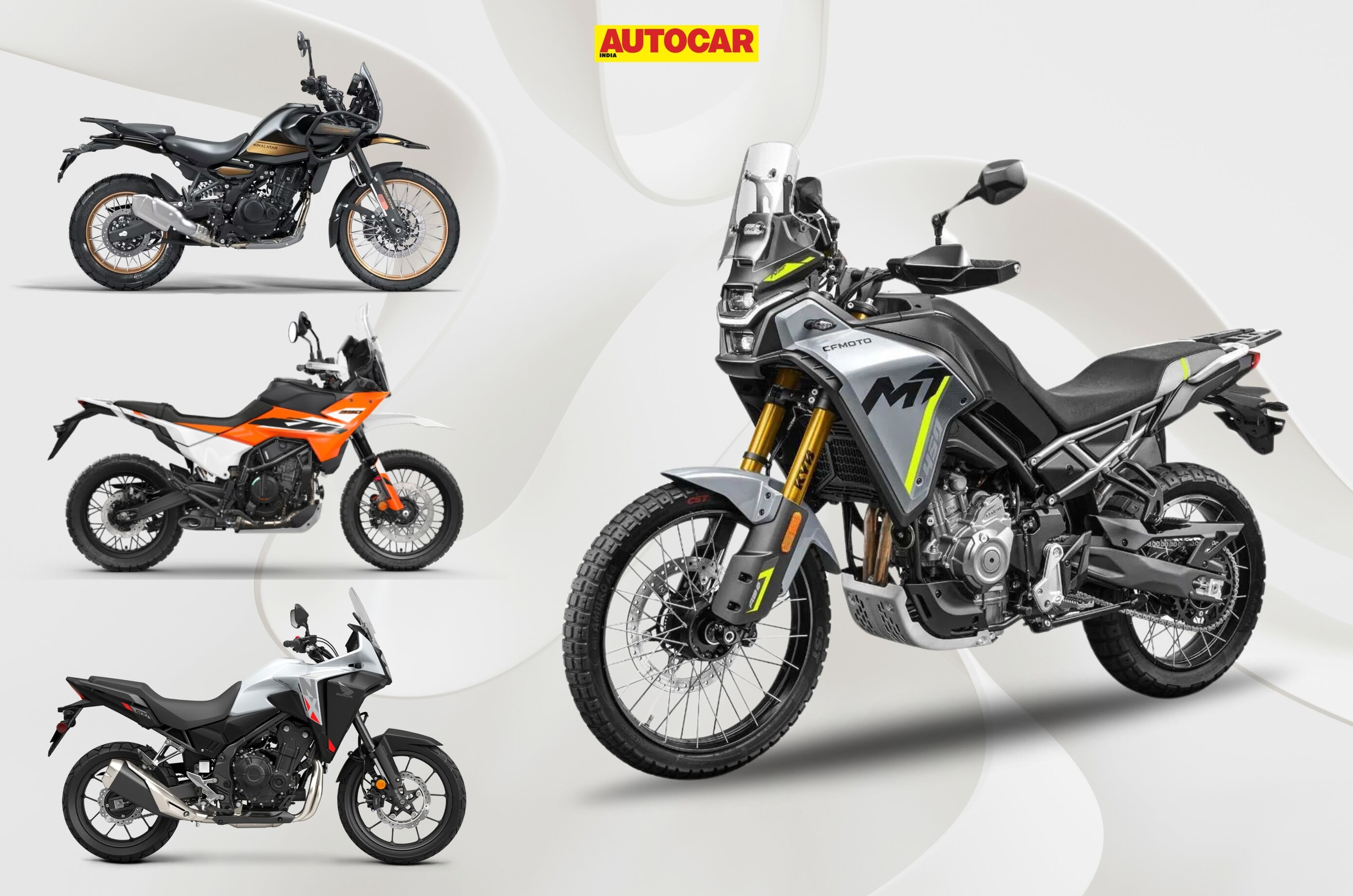CFMoto aims to re-enter the Indian market with the 450MT, and we compare it with its chief rivals.
The 400-500cc ADV segment has become quite competitive lately, with various motorcycles featuring a single-cylinder or a parallel-twin engine. The Royal Enfield Himalayan 450, launched at the end of 2023, is the oldest of the lot, followed by the Honda NX500 and the recently launched KTM 390 Adventure. Now, CFMoto aims to re-enter the Indian market with the 450MT. Here’s how this latest entrant fares compared to some of its key rivals.
CFMoto 450MT vs rivals: engine and output
| Engine and output | ||||
|---|---|---|---|---|
| CFMoto 450MT | KTM 390 Adventure | Royal Enfield Himalayan 450 | Honda NX500 | |
| Engine | Parallel twin, liquid-cooled, 449cc | Single cylinder, liquid-cooled, 399cc | Single cylinder, liquid-cooled, 452cc | Parallel twin, liquid-cooled, 471cc |
| Power | 42hp at 8,500rpm | 46hp at 8,500rpm | 40hp at 8,000rpm | 47.5hp at 8,600rpm |
| Torque | 42Nm at 6,500rpm | 39Nm at 6,500rpm | 40Nm at 5,500rpm | 43Nm at 6,500rpm |
| Gearbox | 6-speed | 6-speed | 6-speed | 6-speed |
| Power-to-weight ratio | 227.02hp/tonne | 252.74hp/tonne | 204.08hp/tonne | 242.34hp/tonne |
The Honda NX500 produces the most power
The KTM 390 Adventure has the best power-to-weight ratio
All four motorcycles in this comparison produce over 40hp. The Himalayan 450 makes the lowest power on paper, followed by the parallel-twin CFMoto 450MT. The KTM 390 Adventure delivers 46hp from its single-cylinder engine, and the NX500 tops the chart with 47.5hp. While all these motorcycles produce peak power at a similar rev range, it is fair to assume that the two parallel-twin ones will be smoother overall.
All bikes are closely matched in torque. The key comparison for real-world performance is their power-to-weight ratio. The CFMoto 450MT’s is decent and better than the Royal Enfield Himalayan 450’s, owing to its lower weight and marginally higher output. It is the highest for the KTM 390 Adventure due to its high-compression single-cylinder engine and lower kerb weight, followed by the NX500 due to its higher power output.
CFMoto 450MT vs rivals: weight and dimensions
| Weight and dimensions | ||||
|---|---|---|---|---|
| CFMoto 450MT | KTM 390 Adventure | Royal Enfield Himalayan 450 | Honda NX500 | |
| Seat height | 800mm – 820mm | 830mm | 805mm – 825mm | 830mm |
| Ground clearance | 220mm | 237mm | 230mm | 181mm |
| Wheelbase | 1,505mm | 1,470mm | 1,510mm | 1,447mm |
| Fuel capacity | 17.5 litres | 14.5 litres | 17 litres | 17.5 litres |
| Kerb weight | 195kg | 182kg | 196kg | 196kg |
The KTM 390 Adventure has the smallest fuel tank
CFMoto is the only one to offer an 870mm accessory seat
The CFMoto 450MT and the Himalayan 450 are the only ones to offer an adjustable seat height. The CFMoto’s seat height goes up to 820mm and can be increased to 870mm with an accessory seat.
In typical KTM fashion, the 390 Adventure is the lightest among its peers but has the smallest fuel tank. It is followed by the CFMoto 450MT, which weighs about 195kg despite having one of the largest fuel tanks.
The Himalayan 450 is the heaviest, weighing equal to the parallel-twin NX500. The Honda can justify this higher kerb weight thanks to its extra cylinder, more power and better power-to-weight ratio. Fuel capacity is also important for adventure tourers, as it contributes to longer range on the highway. Except for the KTM, all three other motorcycles boast a fuel capacity of around 17 litres.
CFMoto 450MT vs rivals: brakes and suspension
| Brakes and suspension | ||||
|---|---|---|---|---|
| CFMoto 450MT | KTM 390 Adventure | Royal Enfield Himalayan 450 | Honda NX500 | |
| Brakes (F/R) | 320mm disc / 240mm disc | 320mm disc / 240mm disc | 330mm disc / 270mm disc | 296mm disc / 240mm disc |
| Suspension (F/R) | USD fork / monoshock | USD fork / monoshock | USD fork / monoshock | USD fork / monoshock |
| Suspension travel (F/R) | 200mm / 200mm | 200mm / 205mm | 200mm / 200mm | NA / NA |
| Wheel size (F/R) | 90/90 R-21 / 140/70 R-18 | 90/90-21 / 130/80-17 | 90/90-21 / 140/80 R-17 | 110/80 R-19 / 160/60 R-17 |
Honda NX500 is the only one to run on a 19/17-inch (F/R) setup
CFMoto 450MT and KTM 390 Adventure get tubeless wheels as standard
First things first, all motorcycles here are equipped with a USD fork and a monoshock. Except for the Honda, for which suspension travel figures aren’t disclosed, all of these bikes have a suspension travel of 200mm.
As for wheel sizes, the Himalayan 450 has a 21-inch wheel at the front and a 17-inch one at the rear. The CFMoto and KTM feature a more traditional off-road-biased 21-inch front and 18-inch rear setup. In contrast, the NX500 is the only one with a road-biased 19-inch front and 17-inch rear setup.
Tubeless tyres should be the norm for adventure tourers, and all the bikes here feature tubeless spoked rims or alloy wheels. The CFMoto and KTM 390 Adventure have tubeless tyres. However, it is pertinent to note that Royal Enfield offers cross-spoke ones as an option for Rs 11,000. The KTM features a patented design incorporating a rubber seal to make the wheels air-tight. The NX500 is the only one with alloy wheels, further emphasising its soft-roader characteristics.
CFMoto 450MT vs rivals: price
| Price | ||||
|---|---|---|---|---|
| CFMoto 450MT | KTM 390 Adventure | Royal Enfield Himalayan 450 | Honda NX500 | |
| Price | To be announced | Rs 3.68 lakh (ex-showroom, Delhi) | Rs 2.85 – Rs 2.98 lakh (ex-showroom, Chennai) | Rs 5.9 lakh (ex-showroom, Delhi) |
The Honda NX500 is the most expensive of the lot
Royal Enfield Himalayan 450 is the most affordable
The Himalayan 450 is the most affordable of the lot, starting at Rs 2.85 lakh and going up to Rs 2.98 lakh. It is available in only one variant, and prices differ based on the colour.
KTM’s 390 Adventure is the most expensive single-cylinder motorcycle among these. However, KTM also offers the 390 Adventure X, which costs Rs 2.91 lakh and is a more road-biased, lower-spec version of the 390 Adventure.
For the CF Moto 450MT, we estimate an ex-showroom price of Rs 3.70 lakh to Rs 4 lakh. If the brand manages to offer the 450MT at this price, it will provide excellent value for money. As for Honda, thanks to the excessive taxes earned by its CBU credentials, the NX500 has the highest price tag among these bikes.
Also see: Hero Xpulse 210 Vs Hero Xpulse 200 4V variants: differences explained


